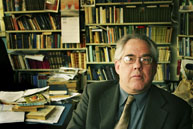Saving Karelian
The border stop of the train between Finland and Russia used to take hours. "It was tense," Paul Austin says. Guards would search the cabins, open doors, lift the ceiling tiles to make sure there were no unexpected passengers, pornography or bibles on the train into Russia, the chair of the Department of Russian and Slavic Studies recalls. Now they just check your papers and passports before wishing you Godspeed into Russia.

Paul Austin, chair of the Department of Russian and Slavic Studies
Claudio Calligaris
Austin first visited Russia during his doctorate studies on an exchange between the University of Toronto and the University of Moscow in the mid–'60s, "the heyday for Soviet citizens," Austin says. It was the beginning of the Brezhnev period and at least food was available. "We thought it was bad in the sixties because we didn't have many vegetables in winter, but by the seventies there was no cheese, eggs were gone, flour was hard to come by. It was really seriously rationed."
In 1968, the founding department chair John Nicholson (who had spent the '40s and '50s teaching Russian to the British intelligence service) invited Austin to join the department. Despite language courses being no longer required at McGill, the Russian department is holding strong at 100 students enrolled in the language courses, and another 100 in Russian literature. He has revived the annual McGill trips to Russia, having recently come back from a 10-day jaunt to St. Petersburg with 10 students in tow (staff can go, too; keep an eye out for advertisements in the fall in the Reporter).
Austin has travelled widely in the Soviet Union, visiting fabled cities like Samarkand, Tashkent and Tbilisi in Georgia, as well as doing two McGill Graduate Society trips on the Volga from Volgograd to St. Petersburg. Now his research focuses on the equally remote Karelia.
He's always had an interest in Russia's language policy. In Central Asian and the Caucasus, including Azerbaijan and Chechnya, languages were originally written in Arabic script. By the '20s, as in Turkey, they were using the Latin alphabet. "Stalin, in the thirties, decided he didn't like how easily the states could communicate with nearby countries by being able read the other's language. So they were given the Cyrillic alphabet to destroy the kind of commonality of communication between the peoples. He feared a kind of Turkification," Austin explains. This also had the effect over time of replacing local Arabic words with standard Russian ones. Today, less forbidding language policies play a role in the preservation of the little-known language Karelian.
Austin had visited Finland, where Russia's national depository library was, from 1809 until the early 20th century ("I don't like to be in a situation that I don't understand, so I learned Finnish," Austin said). He became familiar with the Republic of Karelia — a part of the Russian Federation — which is east of Finland, north of St. Petersburg (Leningrad) and about 700 km by 400 km. Karelia is filled with forests, lakes and wooden churches with fanciful bulbous domes.
Most of people there are Russian nationals, and about 10 percent are Karelian, while Ukrainians, Belorussians, Finns and Veps make up the rest. In a 1989 census, half of the 80,000 Karelians said they speak the language (which is divided into two main dialects), down from 96 percent of a larger population in 1926.
"Karelia's been fought over by Sweden, Russia, Finland, for centuries," Austin says, and the language was never given a written form. After the 1918 revolution, Finnish became Karelia's official language. With the collapse of the Soviet Union, there's been a push to make Karelian official, though the government rejected that proposal in 1998.
But there's hope yet. "In just the last few weeks, the parliament declared Karelian official status where warranted, where the people are. I hope this will spur them forward to making it an official language," Austin adds.
The push from academics and a language commission have been fruitful. There are now radio broadcasts in Karelian, grammar primers for lower-level schools and Karelian newspapers, which devote space to debating new words to add to the language. An issue of the weekly Oma Mua ("Our Land") in Austin's hands proposes words for "snob," temptation," "to sympathize with" and "cathedral."
Yet there remains a dilemma — which Karelian dialect becomes the national language? "In the south they've been farmers, loggers and fishers — they've never had a sophisticated culture of literature. Further north, the dialect tends toward more Finnish," Austin says. Each feels their own language should be the one.
"They have yet to agree on letters to represent sounds," Austin says. Although the Republic voted in 1989 to use a Latin alphabet over a Cyrillic one, spelling varies between the dialects, for example adopting a Finnish letter "y" up north for a sound that in the south is spelled with a German variant of a "u." "To me it's human idiocy," laughs Austin. "Let's write it so the same word is said in the same way." In English a word is spelled one way, no matter how different it may sound when pronounced by a native of Ireland, India or Iowa.
"The problem with Karelia is that it's a big territory with not a lot of people," Austin says. Intermarriage between cultures is high, and many Karelians themselves are indifferent, wondering why they should keep the language — after all, they use Russian or Finnish daily. So why keep the language alive?
"It's a culture. People get upset if a bird doesn't exist. This is part of the world culture. It will be too bad if it disappears, and further lead to a homogenization of the community," Austin says.
Photos by Paul Austin for the 300th anniversary of St. Petersburg are currently on view in the display cases in the Arts Building, Leacock corridor.
